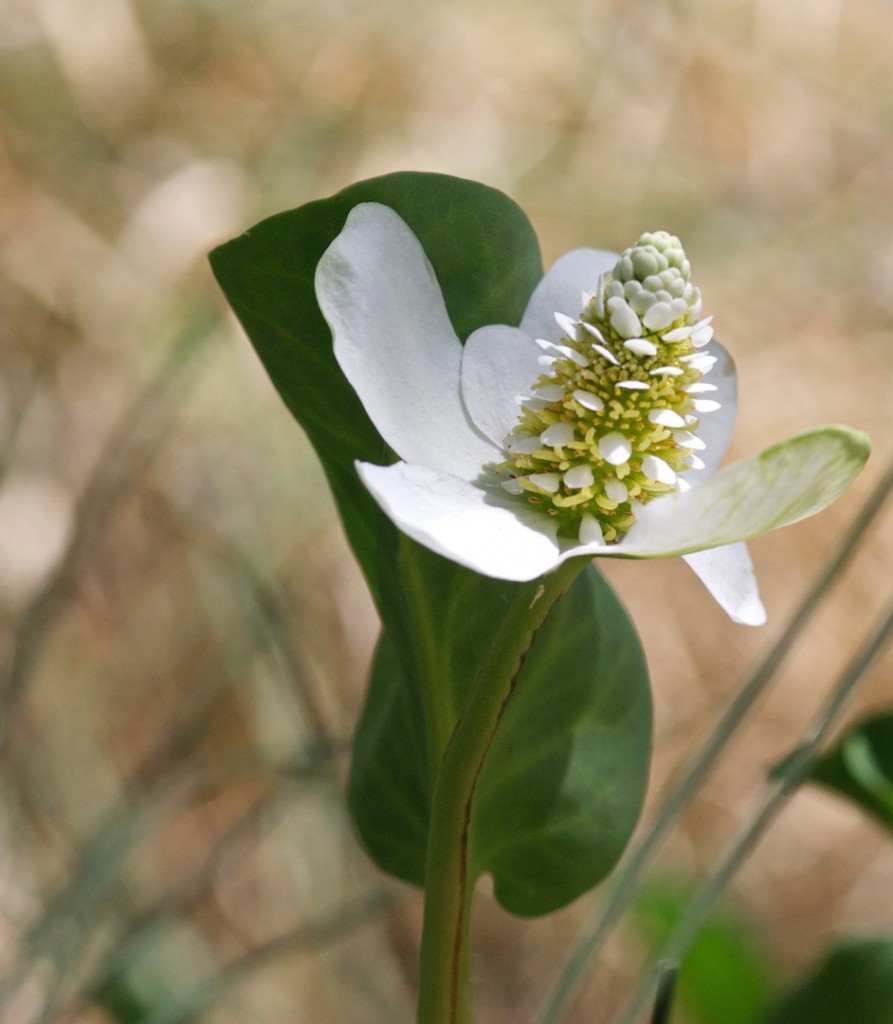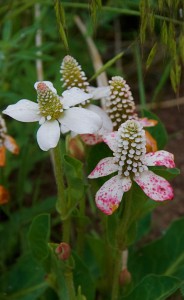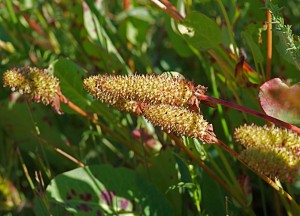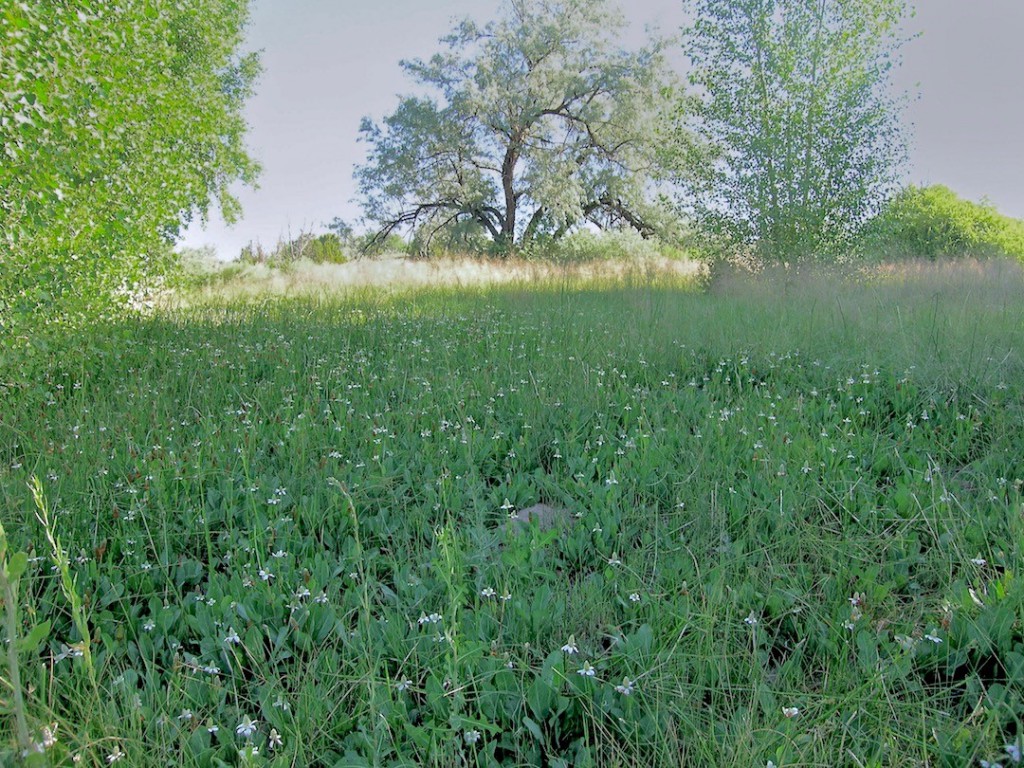Scientific name: Anemopsis californica
Synonyms: A. californica var. subglabra

Close-up of bloom, stem and leaves of yerba mansa (Anemopsis californica) at Leonora Curtin Wetland Preserve by Janice Tucker.
Common names: lizard’s tail, yerba mansa
Family: Saururaceae (common name: Lizard’s tail)
Article by Jeanne Gozigian
During the Triassic Period, from two hundred and forty -three million and two hundred and thirty -one million years ago, dinosaurs arose on the planet Earth, to become the dominant terrestrial vertebrates until the Triassic/Jurassic extinction event of two hundred and one million years ago. The name, dinosaur, comes from the ancient Greek – deinos for terrible and sauros, for lizard. Thus walked the Earth the “terrible lizards” that little boys love to collect and frighten themselves imagining.
Birds are the only creatures of the dinosaur lineage to survive the Cretaceous-Paleogene extinction of sixty six million years ago, the so-called “feathered dinosaurs”. Therefore, dinosaurs are not extinct!* And, we can say that we retain some of the mystery of the age of dinosaurs with members of the Saururaceae, or lizard’s-tail, plant family. It is an ancient family which, according to some sources, predates monocots and dicots. As with the animals, sauros means lizard and oura means tail, referring to the dense, spicate inflorescence typical of plants in this family. It consists of four genera and seven species, all preferring very wet soil or shallow water.

Blooms after the rain and also of the sometimes pink splashes of color on the lower white bracts of yerba mansa (Anemopsis californica) at Leonora Curtin Wetland Preserve by Janice Tucker.
Anemopsis californica is a plant for which the genus, Anemopsis, is monotypic with californica the only species. Its common names are yerba mansa and lizard’s tail.
The scientific name comes from ancient Greek and refers to the flower’s likeness (opsis) to the anemone and californica means “of California”. Yerba mansa, is from the Spanish, yerba being herb, and mansa meaning “tame” or “calm”. Yet, A. californica, despite its formidable medicinal applications, is not a sedative. It has properties for antimicrobial, bacterial and fungal treatments and has been used to treat vaginal candidiasis and the inflammation of arthritis. An infusion of its roots is said to cure gout and excess uric acid, which can lead to kidney stones. Spanish settlers in New Mexico believed it had properties that could help heart problems. If cattails, Typha latifolia, are known as the grocery store of a wetland because of its multiple edible uses, A. californica could be called the wetland drug store. Yerba mansa is a perennial herb native to the southwest of North America and to northwest Mexico. The tiny white flowers (pseudanthia) bloom in the spring on a conical inflorescence, surrounded by four to nine large white bracts. The wavy stems are four to twenty inches in length. The dull green, ovate basal leaves are waxy, smooth (glabra), cool to touch and have a unique, herbal scent. The leaves are hairy on the sides. The fall foliage is quite beautiful, with coppery and purple spots gradually turning to a golden-rusty color. The seeds taste like black pepper, to which it is closely related.

After the bloom “cones” of yerba mansa (Anemopsis californica) at Leonora Curtin Wetland Preserve by Janice Tucker (also note the spots on the leaves in the background).
While these are wetland plants, they can be grown in containers or water features. Plants are available commercially. They spread in natural areas by stolons, strawberry-like runners, forming dense groundcover. The stolons can be cut from the mother plants and put into bare soil to take root. At the Leonora Curtin Wetland Preserve (LCWP) near La Cienega, south of Santa Fe, New Mexico, there are extensive stands of A. californica. LCWP is a Santa Fe Botanical Garden site. It also occurs in the lower Sunrise Class room area of the Ojos y Manos segment of the Botanical Garden at Museum Hill.

Stand of yerba mansa (Anemopsis californica) at Leonora Curtin Wetland Preserve by Janice Tucker.
The Lizard’s- tail family is part of a clade, a group of organisms that retain the characteristics of an ancient ancestor. Pollen from extinct Saururaceae plants has been found by archaeological botanists, so perhaps we are not far wrong in thinking of yerba mansa as descendants from the age of the dinosaurs.
Thanks to Janice Tucker and Helen Woody for proofreading this article.
Sources:
“Anemopsis californica.” Native Plant Information Network, Lady Bird Johnson Wildflower Center, 17 Nov. 2015. Web. 30 May 2018.
“Yerba mansa.” Natural History of Orange County, California and nearby places, School of Biological Sciences University of California, Irvine. Web. 30 May 2018.
Smith, S. Y., & Stockey, R. A. (2007). Pollen morphology and ultrastructure of Saururaceae. Grana, 46(4), 250-267. DOI: 10.1080/00173130701780427
Stearn, W. (2002). Stearn’s dictionary of plant names for gardeners. Portland, Or.: Timber Press.
“The Meaning of Latin Plant Names.” The Seed Site, Web. 30 May 2018.
“Plants Profile for Anemopsis californica (yerba mansa).” USDA, NRCS. 2018. The PLANTS Database (http://plants.usda.gov, 30 May 2018). National Plant Data Team, Greensboro, NC 27401-4901 USA.
“Anemopsis.” Wikipedia. Wikimedia Foundation, 27 May 2018. Web. 30 May 2018.
* “Using the tree for classification”, University of Berkley, U of CA Press, from Wikipedia article on Saururaceae


